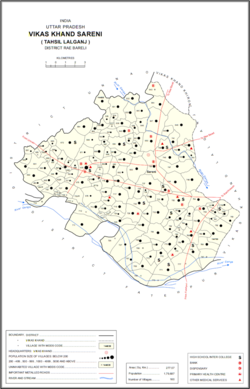Singhaur Tara
Village in Uttar Pradesh, India From Wikipedia, the free encyclopedia
Village in Uttar Pradesh, India From Wikipedia, the free encyclopedia
Singhaur Tara is a village in Sareni block of Rae Bareli district, Uttar Pradesh, India.[2] It is located on the bank of the Ganges,[3] 18 km from the tehsil headquarters at Lalganj.[4] Singhaur Tara is probably identical with the mahal called "Tara Singhaur" Ain-i-Akbari in the late 16th century.[3] This mahal was in the sarkar of Lucknow.[3] It was later merged into the pargana of Sareni under the Nawabs of Awadh in the 1700s.[3]
Singhaur Tara
Singhaur Tāra | |
|---|---|
Village | |
 Map showing Singhaur Tara Mu. (#788) in Sareni CD block | |
| Coordinates: 26.058631°N 80.878223°E[1] | |
| Country | |
| State | Uttar Pradesh |
| District | Raebareli |
| Area | |
• Total | 4.11 km2 (1.59 sq mi) |
| Population (2011)[2] | |
• Total | 1,707 |
| • Density | 420/km2 (1,100/sq mi) |
| Languages | |
| • Official | Hindi |
| Time zone | UTC+5:30 (IST) |
| Vehicle registration | UP-35 |
As of 2011, Singhaur Tara has a population of 1,707 people, in 304 households.[2] It has one primary school and no healthcare facilities, and does not host a permanent market or a weekly haat.[2]
The 1951 census recorded Singhaur Tara (as "Singhaurtara") as comprising 9 hamlets, with a total population of 870 people (446 male and 424 female), in 158 households and 149 physical houses.[5] The area of the village was given as 1,476 acres.[5] 66 residents were literate, 64 male and 2 female.[5] The village was listed as belonging to the pargana of Sareni and the thana of Sareni.[5]
The 1961 census recorded Singhaur Tara (as "Singhaurtara") as comprising 9 hamlets, with a total population of 986 people (494 male and 492 female), in 187 households and 169 physical houses.[6] The area of the village was given as 1,094 acres.[6]
The 1981 census recorded Singhaur Tara as having a population of 1,252 people, in 208 households, and having an area of 410.76 hectares.[4] The main staple foods were given as wheat and rice.[4]
The 1991 census recorded Singhaur Tara (as "Sidhaur Tara Mu.") as having a total population of 1,478 people (737 male and 741 female), in 248 households and 248 physical houses.[7] The area of the village was listed as 411 hectares.[7] Members of the 0-6 age group numbered 284, or 19% of the total; this group was 51% male (145) and 49% female (139).[7] Members of scheduled castes made up 20% of the village's population, while no members of scheduled tribes were recorded.[7] The literacy rate of the village was 26% (299 men and 80 women).[7] 501 people were classified as main workers (341 men and 160 women), while 66 people were classified as marginal workers (1 man and 65 women); the remaining 911 residents were non-workers.[7] The breakdown of main workers by employment category was as follows: 348 cultivators (i.e. people who owned or leased their own land); 90 agricultural labourers (i.e. people who worked someone else's land in return for payment); 5 workers in livestock, forestry, fishing, hunting, plantations, orchards, etc.; 0 in mining and quarrying; 3 household industry workers; 4 workers employed in other manufacturing, processing, service, and repair roles; 0 construction workers; 6 employed in trade and commerce; 4 employed in transport, storage, and communications; and 51 in other services.[7]
Seamless Wikipedia browsing. On steroids.
Every time you click a link to Wikipedia, Wiktionary or Wikiquote in your browser's search results, it will show the modern Wikiwand interface.
Wikiwand extension is a five stars, simple, with minimum permission required to keep your browsing private, safe and transparent.